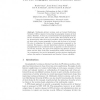Free Online Productivity Tools
i2Speak
i2Symbol
i2OCR
iTex2Img
iWeb2Print
iWeb2Shot
i2Type
iPdf2Split
iPdf2Merge
i2Bopomofo
i2Arabic
i2Style
i2Image
i2PDF
iLatex2Rtf
Sci2ools
HSNMC
2004
Springer
2004
Springer
Two-Tier Geographic Location of Internet Hosts
Multimedia delivery systems, such as Content Distribution Networks (CDNs), improve by knowing the geographic location of their clients. Therefore, we focus on a measurement-based geographic location service of Internet hosts. Such a service infers host locations from delay measurements taken from probe machines toward landmarks, which are hosts with a known geographic location, and the host to be located. We aim at mitigating the number of measurements generated in the network. We propose a two-tier hierarchical structure of landmarks to geographically locate an Internet host as opposed to a flat structure. In our two-tier structure, the upper level mitigates long distance measurements and the lower level keeps measurements within restricted areas. As a consequence, the two-tier geographic location structure significantly reduces the number of measurements and thereby it favors scalability.
Geographic Location | HSNMC 2004 | Measurement-based Geographic Location | Measurements | Multimedia |
| Added | 01 Jul 2010 |
| Updated | 01 Jul 2010 |
| Type | Conference |
| Year | 2004 |
| Where | HSNMC |
| Authors | Bamba Gueye, Artur Ziviani, Serge Fdida, José Ferreira de Rezende, Otto Carlos Muniz Bandeira Duarte |
Comments (0)

